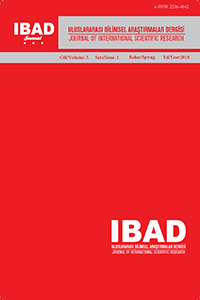Öz
The objective of this
study is to investigate Turkey’s trade deficit through examining the dynamics
of trade balance in order to understand which of the variables deteriorate this
deficit and also in what manner these variables affect trade balance. In this
respect, the real exchange rate effect on trade balance both in the short run
and long run has been examined by using quarterly data set from 1992 to 2011
for Turkey. The Vector Error Correction Model (VECM) is applied with Johansen
co-integration analysis, Granger causality test and generalized impulse
response analysis. According to Johansen cointegration analysis, under trace
and maximum eigenvalue tests variables found cointegrated which means there is
long run relationship among variables. This result enables us to apply VECM.
Anahtar Kelimeler
Kaynakça
- Akbostancı, E. and G.I. TUNÇ (2002), “Turkish Twin Deficits: an Error Correction Model of Trade Balance,” ERC Working Papers, 01(06).
- Akbostancı, E (2002), “Dynamics of the Trade Balance: The Turkish J-Curve.” ERC Working Papers, 02/05
- Akhtar, M. ve Hilton R. S (1984), “Effects of Exchange Rate Uncertainity on German and U.S. Trade”, Federal Reserve Bank of New York, Quarterly Review, 9 Alptekin, V. (2009). “Türkiye’de Dış Ticaret ve Reel Döviz Kuru İlişkisi: Vektör Otoregresyon (VAR) Analizi Yardımıyla Sınanması” Niğde Üniversitesi İİBF Dergisi Cilt: 2, Sayı: 2, s.132-149 Arize, A. C. (1994), “Cointegration Test for a Long-run Relation between the Real Effective Exchange Rate and the Trade Balance.” International Economic Journal Volume 8, No:3 Bahmani-Oskooee, M. (1991), “Is There a Long-run Relation Between the Trade Balance and the Real Effective Exchange Rate of LDCs?” Economic Letters, 403- 407.
- Boyd, Derick, and Caporale, Gugielmo Maria and Smith Ron (2001) “Real Ex change Rate Effects on the Balance of Trade: Cointegration and the Marshall-Lerner Condition,” International Journal of Finance and Economics, 6, 187-200.
- Chinn, M. and Wei, S-J. (2008), “A Faith-based Initiative: Do We Really Know that a Flexible Exchange Rate Regime Facilitates Current Account Adjustment?” NBER Working Paper, No. 14420.
- Demir M. and Sever E. (2007) “Türkiye’de Bütçe Açığı ile Cari Açık Arasındaki İlişkilerin VAR Analizi ile İncelenmesi” Eskişehir Osmangazi Üniversitesi İİBF Dergisi, Nisan 2007, 2(1): 47-63
- Erkılıç, S. (2006), “Türkiye’de Cari Açığın Belirleyicileri (Uzmanlık Yeterlilik Tezi)” (Ankara:Türkiye Cumhuriyet Merkez Bankası İstatistik Genel Müdürlüğü).
- Goldstein, M. and Khan M.S. (1985). “Income and Price Effects in Foreign Trade”, Handbook of International Economics, Vol II: 1041–1105
- Işiker M., (2012), The effect of exchange rate on trade deficit, Queen Mary University, London, 110536848
- Kimbugwe, H. (2006). "The bilateral J-Curve hypothesis between Turkey and her 9 trading partners," MPRA Paper 4254, University Library of Munich
- Onafowora, O. (2003), “Exchange Rate And Trade Balance in East Asia: Is There A J Curve?,”Economics Bulletin, 5(18): 1-13.
- Peker, O. and Hotunoğlu H. (2009), “Türkiye’de Cari Açığın Nedenlerinin Ekonometrik Analizi,” Atatürk Üniversitesi, İ.İ.B.F. Dergisi, 23(3): 221–237.
- Rose, A.K and Yellen, J.L (1989). “Is There a J-Curve?” Journal of Monetary Economics 24, 53-68.
- Vergil, H. (2002). “Exchange Rate Volatility in Turkey and Its Effect on Trade Flows.” Journal of Economic and Social Research 4 (1), 83–99
- Yapraklı S. (2010) “The Determinants of Foreign Trade Deficits Under Floating Exchange Rate Regime: Bounds Test Approach” Ankara Üniversitesi Siyasal Bilgiler Fakültesi Dergisi, 2010; 65(4): 143-163
Ayrıntılar
| Bölüm | Makaleler |
|---|---|
| Yazarlar | |
| Yayımlanma Tarihi | 31 Ağustos 2018 |
| Yayımlandığı Sayı | Yıl 2018 Cilt: 3 Sayı: 1 |
Kaynak Göster
IBAD Sosyal Bilimler Dergisi / IBAD Journal of Social Sciences / IBAD
IBAD, EBSCO, SCOPUS, E-SCI ve TÜBİTAK/ULAKBİM(TR) SBVT tarafından DİZİNLENMEK ÜZERE değerlendirme sürecindedir.
Dergimizin sekreterya ve dizin/indeks takibi işlemleri dergieditoru.com tarafından yürütülmektedir.


